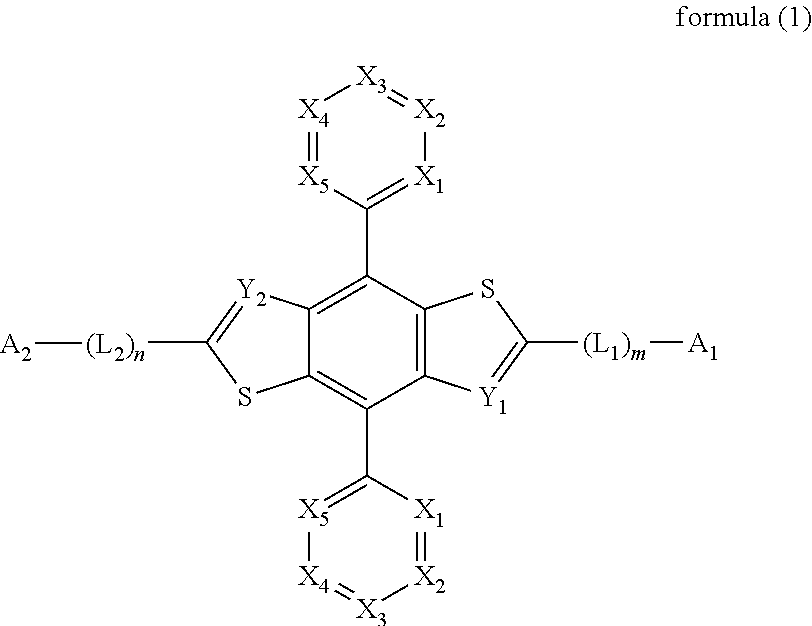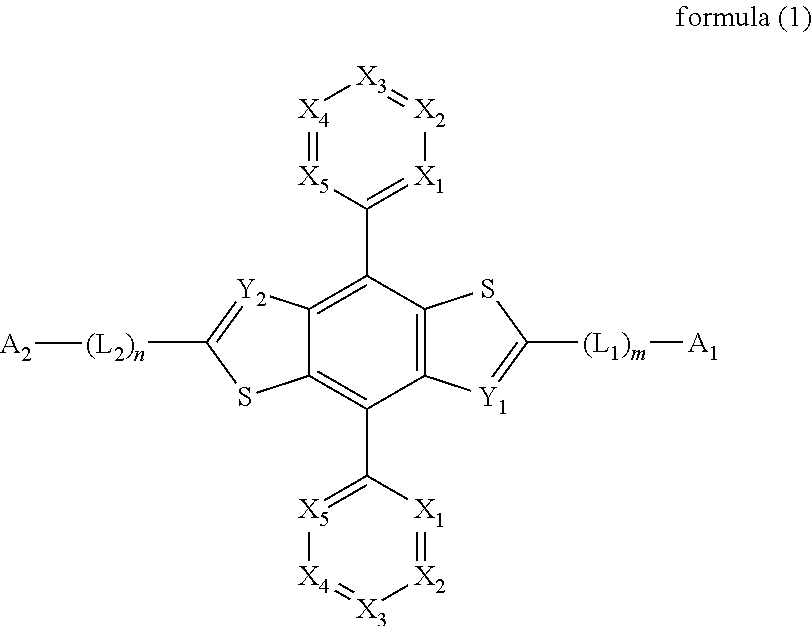Organic compound for organic EL device and using the same
a technology of organic el and compound, which is applied in the field of organic compound and organic electroluminescence, can solve the problems of unsatisfactory efficiency and driving voltage of industrial practice use, only 25% internal quantum efficiency of fluorescence electroluminescent device, and unsatisfactory efficiency and half-life of phosphorescent host material used for emitting layer, etc., and achieves excellent thermal stability, long half-life time, and high luminance efficiency
- Summary
- Abstract
- Description
- Claims
- Application Information
AI Technical Summary
Benefits of technology
Problems solved by technology
Method used
Image
Examples
example 1
Synthesis of Compound 1
Synthesis of 4,8-diphenylbenzo[1,2-b:4,5-b′]dithiophene
[0025]
[0026]A mixture of 5 g (22.7 mmol) of 4,8-dihydrobenzo [1,2-b:4,5-b′] dithiophene-4,8-dione and 400 mL of THF was cooled in an ice bath and the 90.8 mL of phenylmagnesium bromide (1M in THF, 90.8 mmol) was dropwise into then reflux for 1 h. The resulting mixture was allowed to cool to room temperature, and the solution of tin chloride (70 g in 120 mL 10% HCl, 0.34 mole) was dropwise into then reflux for 2 h. The resulting mixture was allowed to cool to room temperature and the solution was removed. The 200 mL of methanol was added, then filtered to get the brown solid, yield (6 g, 77.2%). 1H NMR (CDCl3, 400 MHz): chemical shift (ppm) 7.76-7.78 (dd, 4H), 7.40-7.52 (m, 10H).
Synthesis of 2-bromo-4,8-diphenylbenzo[1,2-b:4,5-b′]dithiophene
[0027]
[0028]A mixture of 2 g (5.84 mmol) of 4,8-diphenylbenzo [1,2-b:4,5-b′] dithiophene and 300 mL of THF was cooled in a dry ice bath and the 3.5 mL of n-butyllithium ...
example 2
Synthesis of Compound 3
Synthesis of 2,6-dibromo-4,8-diphenylbenzo[1,2-b:4,5-b′]dithiophene
[0031]
[0032]A mixture of 2 g (5.84 mmol) of 4,8-diphenylbenzo [1,2-b:4,5-b′] dithiophene and 300 mL of THF was cooled in a dry ice bath and the 7 mL of n-butyllithium (2.5M in Hexane, 17.52 mmol) was dropwise into then stir for 1 h in a dry ice bath. The resulting mixture was stirred for 1 h at the room temperature then the resulting mixture was cooled in a dry ice bath and the 2.8 mL of 1,2-dibromotetrachloroethane (23.36 mmol) was dropwise into then stir for 1 h in a dry ice bath then the resulting mixture was stirred at the room temperature for 12 h. The 50 mL of water was added, then removed the solution. The 50 mL of methanol was added, then filtered to get the white solid, yield (2.3 g, 79%). 1H NMR (CDCl3, 400 MHz): chemical shift (ppm) 7.42-7.53 (m, 10H), 7.24 (s, 2H).
Synthesis of Compound 3
[0033]
[0034]A mixture of 2 g (4 mmol) of 2,6-dibromo-4,8-diphenylbenzo[1,2-b: 4,5-b′]dithiophene ...
example 3
Synthesis of Compound 9
[0035]
[0036]3,5-Dicyanophenylboronic acid instead of 2,4-diphenyl-6-(3-(4,4,5,5-tetramethyl-1,3,2-dioxaborolan-2-yl)phenyl)-1,3,5-triazine, except for using the same method as in synthesis Example 1, the desired compound of 2-(3,5-dicyanobenzyl)-4,8-diphenylbenzo[1,2-b:4,5-b]dithiophene was obtained. MS (m / z, EI+): 468.8
PUM
| Property | Measurement | Unit |
|---|---|---|
| triplet energy | aaaaa | aaaaa |
| internal quantum efficiency | aaaaa | aaaaa |
| internal quantum efficiency | aaaaa | aaaaa |
Abstract
Description
Claims
Application Information
 Login to View More
Login to View More - R&D
- Intellectual Property
- Life Sciences
- Materials
- Tech Scout
- Unparalleled Data Quality
- Higher Quality Content
- 60% Fewer Hallucinations
Browse by: Latest US Patents, China's latest patents, Technical Efficacy Thesaurus, Application Domain, Technology Topic, Popular Technical Reports.
© 2025 PatSnap. All rights reserved.Legal|Privacy policy|Modern Slavery Act Transparency Statement|Sitemap|About US| Contact US: help@patsnap.com



